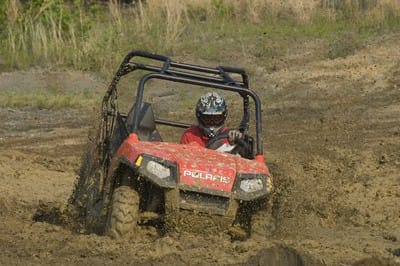
A hard season of riding your ATV demands that you give back a little TLC. Although modern bikes need less maintenance than they used to, there’s always a few basics that will need your attention. Before you get started, pull out your owner’s manual for specific information on maintenance frequency, correct fluid values and torque settings.
Consider investing in a repair manual for your specific ATV brand and model. And next time you’re on the web, go to “You Tube”, type in the brand of bike and maintenance, or repair or even ATV repair. You’ll be amazed at all the tutorials you’ll find.
Power Bath
There’s a good chance that your bike has picked up some crud recently, and it’s important to give it a thorough power wash to keep cables free, heat from building up, and rust at bay.
Go to a manual car wash and spray your bike down to thoroughly remove grit and mud before your maintenance day. It will make the parts easier to access, and much more efficient to remove. Don’t forget to clean the radiator.
Breathe Easier
All bikes have an air cleaner, and should be replaced every a least every 50 hours of operation. First consider your riding terrain; if you’re in dry dirt every day, it needs to be replaced more frequently. If you pull out your air filter and you can’t see daylight through the paper, change it. You will notice the difference immediately.
Life Blood
Just like the car you drive, oil keeps your machine in shape. If your oil is full of pesky particulate matter, your engine will not live a long life. So…change your oil every 100 hours, or 1000 miles, and or least once a year if you’re not running close to the time intervals. If dust is part of your every day ride, change it as soon it looks dirty. And always change the filter, every time.
The Other Life Blood
Bikes take baths, it’s what they do. And, if you’re like most riders, you live to run through mud holes. What so many owners forget to do is to check the differential fluid for contaminants. Remove the plug hole and insert a clean, clear zip tie. If there is any debris or if you find a milky color, change the fluid immediately.

Tighten Up
At least once a year, I like to pull out my torque wrench, a socket set and check almost every nut and bolt I can reach. The suspension is where most loose nuts and bolts will reside. Beware, loose hardware can also be devastating to engine mounts, exhausts, and differentials. This is a great annual habit to acquire. Just make sure you first identify every nut and bolt’s torque value in your repair manual before you turn.
Booties
Get under your bike and check the rubber CV boots on each wheel. Don’t forget the rubber vent bellows on the front differential and rear gearbox. If there are leaks or tears, replace them immediately or you may require an expensive trip to your dealer for a new CV axle.
Fuel Conditioner
One of the most nagging problems with non-fuel injected ATV’s is they can develop troublesome moisture in the fuel lines, tanks or carburetors. If your bike isn’t going to roll for more than a month, or if the temperature is going to drop below freezing, add a dose of Sta-bil fuel additive to your tank. Don’t add more because you think it will do a better job—just make sure you follow the directions.







